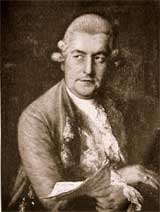J.C. Bach Biography - A Very Quick Guide
Artist:
J.C. Bach
Born:
September 5, 1735 , Leipzig
Died:
January 1, 1782, London
Who Was Johann Christian Bach?
Johann Christian Bach (1735–1782) was a German composer and the youngest son of Johann Sebastian Bach. Known as the “London Bach,” his music bridges the Baroque and Classical eras, influencing the young Mozart.
What Is J.C. Bach Best Known For?
J.C. Bach is best known for his symphonies, keyboard concertos, and operas, which helped shape the emerging Classical style. His music abandoned the dense counterpoint of his father in favour of clarity, balance, and lyrical melody. Works such as his Keyboard Concerto Op. 7 and Symphony Op. 18 are among his best known.
Why Was He Called the “London Bach”?
After studying in Italy, J.C. Bach moved to London in 1762, where he became a court musician to Queen Charlotte. His success in London earned him the nickname “the London Bach,” distinguishing him from his brothers Carl Philipp Emanuel and Wilhelm Friedemann.
When Was Johann Christian Bach Born?
He was born on September 5, 1735, in Leipzig, Germany, the youngest child of Johann Sebastian Bach and Anna Magdalena. After his father’s death, he studied under his half-brother C.P.E. Bach in Berlin before moving to Italy, where he absorbed the operatic style that would define his career.
How Did J.C. Bach Die?
Johann Christian Bach died on January 1, 1782, in London, at the age of 46.
10 Facts About Johann Christian BachHe was the youngest of Johann Sebastian Bach’s sons. He studied composition in Italy with Padre Martini. He converted to Catholicism while living in Milan. He composed numerous operas for Italian and English theatres. He was one of the first to write piano concertos specifically for the newly developed fortepiano. He co-founded the Bach–Abel concerts in London, among the first public concert series in Europe. He taught music to Queen Charlotte of England. Mozart met him in London in 1764 and deeply admired his music. His style helped pave the way for the early Classical sound of Haydn and Mozart. His music fell into obscurity after his death but has since been rediscovered for its elegance and influence.
Johann Christian Bach (1735–1782) was a German composer and the youngest son of Johann Sebastian Bach. Known as the “London Bach,” his music bridges the Baroque and Classical eras, influencing the young Mozart.
What Is J.C. Bach Best Known For?
J.C. Bach is best known for his symphonies, keyboard concertos, and operas, which helped shape the emerging Classical style. His music abandoned the dense counterpoint of his father in favour of clarity, balance, and lyrical melody. Works such as his Keyboard Concerto Op. 7 and Symphony Op. 18 are among his best known.
Why Was He Called the “London Bach”?
After studying in Italy, J.C. Bach moved to London in 1762, where he became a court musician to Queen Charlotte. His success in London earned him the nickname “the London Bach,” distinguishing him from his brothers Carl Philipp Emanuel and Wilhelm Friedemann.
When Was Johann Christian Bach Born?
He was born on September 5, 1735, in Leipzig, Germany, the youngest child of Johann Sebastian Bach and Anna Magdalena. After his father’s death, he studied under his half-brother C.P.E. Bach in Berlin before moving to Italy, where he absorbed the operatic style that would define his career.
How Did J.C. Bach Die?
Johann Christian Bach died on January 1, 1782, in London, at the age of 46.
10 Facts About Johann Christian Bach
Top Pieces on 8notes by J.C. Bach
